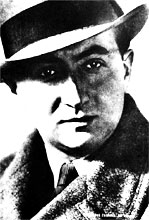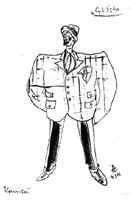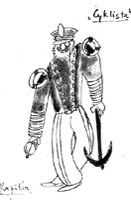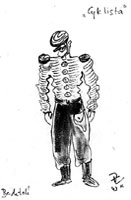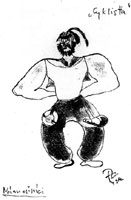Czech Theater in Terezin w Posters w Drama w Stage Design w Musicw Revues and Cabarets w Titbits about Schwenk w Puppet Theatre w Performances for Children w Home
|
|
|
1. Frantishek Zelenka. Set design for The Third Ring.
1943
2.Terezin street, summer 1942
|
In 1925, architect and set designer Frantishek Zelenka comes to The Liberated Theater in Prague. Together with the legendary Voskovec – Werich – Jezek ensemble, he contributed to creation of the new Czech theater. In Terezin, within 15 months, Zelenka mounted 25 performances: cabaret, drama and opera.
A leading Brno magazine Eva published his photographs, drawings and articles in 1931-1938. His credo was ‘a new-type comfort,’ everything simple but elegant. But then – pure order should be disturbed, a thing like a newspaper tossed randomly can transform bare functionality to an atmosphere of a home. He started in the National Theater in 1928. Here was a young, modernist and anti-romanticist artist, working in a classical-type theater! However, he scored successes and gained popularity. All theaters open their doors to him, but his love for humor and anti-civilization parody brings him to the Liberated Theater. The stars of the stage, Jiri Voskovec and Jan Werich, and jazz composer Jaroslav Jezek who joined them in 1929 were engaged in frantic experiments that paved the way for the new Czech theater. They accepted Frantishek Zelenka as one of their own. Bright, burlesque shows, with boisterous music, satiric dialogues, stage design using neon ads, signposts, telegraph bands with Morse alphabet… Ironically, the show Last Vacation crowned Zelenka’s career in Prague theater. Zelenka started another life that was hardly spectacular. He worked in the Jewish Community, registering Jewish cultural objects that were confiscated from Jews. This work gave Frantishek, his wife Anna and little Martin an extra year of ‘freedom’: at least they were not deported to a concentration camp. They held out till summer of 1943. Zelenka’s last job assignment, born in a morbid imagination of some top Nazi functionary, was truly surrealistic. In the summer of 1942, he and his colleague Josef Pollak kept feverishly busy, arranging pilfered Jewish religious objects into exhibitions. As some historians maintain, it was a part of a broader plan: to establish, after the Jews are liquidated, The Museum of Extinct (Jewish) Race. Four exhibits, made within one year, somehow did not make the clients happy. Zelenka had failed as designer, perhaps for the first time. His next assignment, in Terezin, was to be another failure. He would refuse orders to participate in the creation of a Nazi propaganda film and suffer a savage beating. But that was to come later. At this moment, on July 15th 1943, Zelenka arrived in Terezin with his family. He looked with amazement around and saw an unparalleled cultural boom in progress. Frantishek Zelenka, a living legend, was a hot commodity from the start. In no time, he became the boss of the theatrical section of Free Time Department; his wife Anna was active there too. After coming to Terezin, Zelenka plunged into melancholy. "He drew obsessively in his sketch book", a witness recalls. "He suffered from depression, and that was obviously his way of dealing with it. He never noticed what was going around him, even whether anybody was looking at him. He was sketching costumes, mise en scenes, programs, even for those pieces that were not yet approved for production. Zelenka was a fanatic of the theater." O.Ruzhichka Despite his depression, Zelenka intensely worked and designed sets for Moliere, Gogol, Shakespeare, cabaret shows by Karel Schwenk and Kurt Gerron, and other productions. In July 1944, in the last quiet period before the devastating autumn transports to Auschwitz, Zelenka writes into an album of a friend: "To survive in Terezin, so that later, at large, to realize this experience, to separate grains from tare, - in this the power of the artist will manifest itself." Architect Zelenka did not live up to freedom. The first exhibition of his works took place in Prague, half century after his death. E.M. |
|
|
|||
|
|
|
|
|
|
F. Zelenka. Costumes for The Last
Bicyclist . 1943 |

